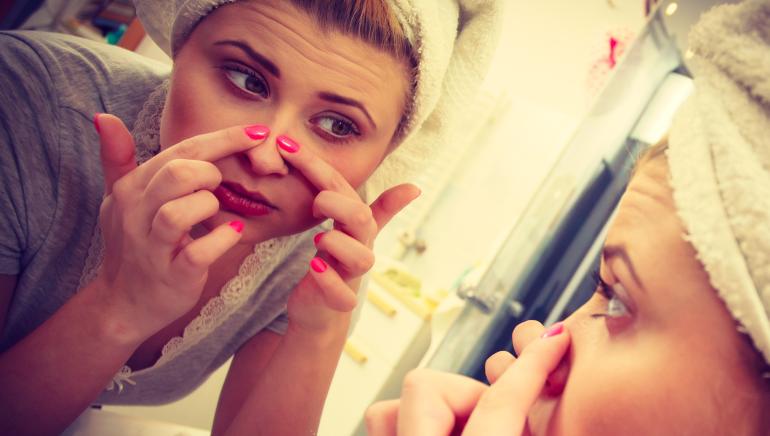
Whiteheads can appear on different parts of the body, but are mostly found on the nose. Know the causes of whiteheads on the nose and how to get rid of them.
When dead skin cells, bacteria, and oil get trapped within one of your skin pores, a whitehead, a type of acne, gets formed. You can find whiteheads anywhere on your body, including your back, chest, and arms. But your nose, which is part of the T-zone, may be particularly prone to whiteheads. That’s because the T-zone, which also includes chin and forehead, is the most oily parts of your face. Poor skincare habits and hormonal fluctuations may increase your chances of developing whiteheads. They may be stubborn, but there are over-the-counter treatments and home remedies that can help get rid of whiteheads on the nose.
What are whiteheads?
Whiteheads are a type of acne that occurs when pores or hair follicles become clogged with oil (sebum), dead skin cells, and bacteria. “They appear as small, white, or flesh-coloured bumps on the skin’s surface and are non-inflammatory,” says cosmetologist and skin expert Dr Jatin Mittal.

They do not cause redness or swelling like other forms of acne, such as pimples or cysts. Whiteheads develop when the contents of the clogged pore remain trapped beneath the surface of the skin, preventing air exposure and oxidation. They are most commonly found on areas of the body that produce more oil, such as the face, particularly on the nose.
What causes whiteheads on the nose?
Whiteheads on the nose occur due to several factors, many of which are related to excess oil production and clogged pores. “The nose, along with the forehead and chin (forming the T-zone), is particularly prone to whiteheads because it has a higher concentration of sebaceous glands, which produce oil,” says the expert.
Here are some of the causes:
- Excess oil: The nose produces more oil than other areas of the face, leading to an increased risk of clogged pores.
- Dead skin cells: When dead skin cells are not properly exfoliated, they can accumulate in the pores, mixing with oil and bacteria to form whiteheads.
- Hormonal fluctuations: Hormonal changes, particularly during puberty, menstruation, and pregnancy, can cause an increase in sebum production, leading to more whiteheads.
- Cosmetics and skincare products: Heavy or comedogenic products can block pores, especially on the oily areas of the face like the nose.
- Diet: A diet high in refined sugars, dairy, or greasy foods can contribute to skin issues, including whiteheads.
- Environmental factors: Pollution, humidity, and exposure to dirt can contribute to the buildup of impurities in the skin.
- Improper cleansing: Not cleansing the skin regularly or thoroughly can result in dirt, oil, and dead skin cells clogging the pores.
Are there complications of whiteheads on the nose?
Whiteheads are generally considered a mild form of acne and do not typically lead to serious complications. “However, if they are not properly managed, they can lead to several issues, particularly in people who frequently pick or pop them,” says Dr Mittal. Here are potential complications:
- Infection: Squeezing or picking at whiteheads can introduce bacteria into the skin, causing infection or more severe forms of acne like cysts and nodules.
- Scarring: Improperly handling whiteheads, especially by forcefully popping them, can result in scars, which may be difficult to treat.
- Hyperpigmentation: Even if the whiteheads heal without scarring, they may leave behind dark spots or patches known as post-inflammatory hyperpigmentation, which can take weeks or months to fade.
- Progression to other acne types: If whiteheads are not treated, the buildup of bacteria and oil in the pores may lead to more inflammatory types of acne, such as papules, pustules, or cystic acne.
- Enlarged pores: Over time, clogged pores may stretch, and lead to enlarged pores, especially if the skin is oily.
- Emotional impact: While whiteheads are typically mild, persistent acne can affect self-esteem and emotional well-being, especially when occurring in visible areas like the nose.
How to get rid of whiteheads on the nose?
Here are some of the ways to get rid of whiteheads on the nose:
1. Salicylic acid cleanser
Cleaning your face properly with the right cleanser is one of the most important steps to do away with whiteheads. “Use a gentle cleanser containing salicylic acid, as it exfoliates the skin and clears pores,” says the expert. Use salicylic acid cleanser daily to get rid of whiteheads.
2. Benzoyl peroxide spot treatment
Benzoyl peroxide is an active ingredient that reduces bacteria that causes acne, according to the American Academy of Dermatology Association. Use benzoyl peroxide as spot treatment one or two times a day to reduce bacteria and oil.
3. Clay mask
Look for a clay mask for skin with ingredients like bentonite or kaolin. “Use the clay mask one or two times in a week so that excess oil gets absorbed,” says Dr Mittal.
4. Retinoids
Use a retinoid to unclog pores, according to the American Academy of Dermatology Association. Retinoid-based products increase cell turnover and prevent clogged pores, but only use every other night to avoid irritation.

5. Tea tree oil
It has good antibacterial, anti-inflammatory, and antioxidant properties, so it may help to combat whiteheads. Mix a few drops of tea tree oil with a carrier oil and apply it to the affected area once daily.
6. Honey and cinnamon mask
A 2016 study published in the Journal of Microbiology, Immunology and Infection found that honey can work against some of the microbes that play a role in the formation of acne. In another study, published in Biomedical Research and Therapy in 2019, topical cinnamon gel was found to be efficient and safe for the treatment of acne. So, mix honey with cinnamon, and apply the paste to your face. Leave it on for 10 to 15 minutes to reduce bacteria and inflammation. Use this DIY honey and cinnamon face mask two to three times a week.
7. Exfoliate with AHA/BHA
Use an exfoliant with alpha hydroxy acids (AHA) or beta hydroxy acids (BHA) to remove dead skin cells. “Use the exfoliant two to three times weekly,” suggests the expert.
8. Apple cider vinegar
Apple cider vinegar has antimicrobial, antibacterial, anti-inflammatory properties, as per research published in the AGROFOR International Journal in 2019. Dilute apple cider vinegar with water (1:2 ratio) and apply it as a toner daily to balance skin pH and reduce whiteheads.
9. Steam facial
Steam your face for 5 to 10 minutes so that it can open up your pores. Once that happens, it will be easier to clean your face. “Do this once a week,” suggests the expert.
Avoid the urge to pop or pick whiteheads on the nose, maintain a consistent skincare routine and adopt healthy habits that keep your pores clear.









